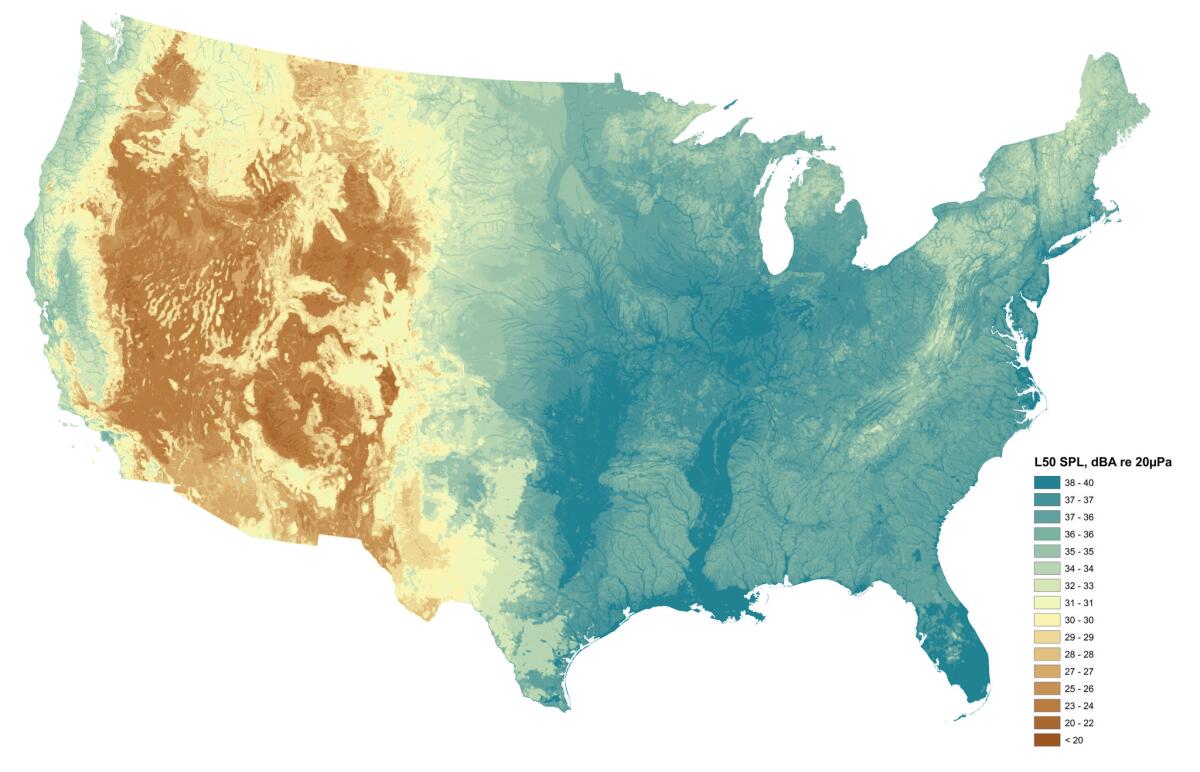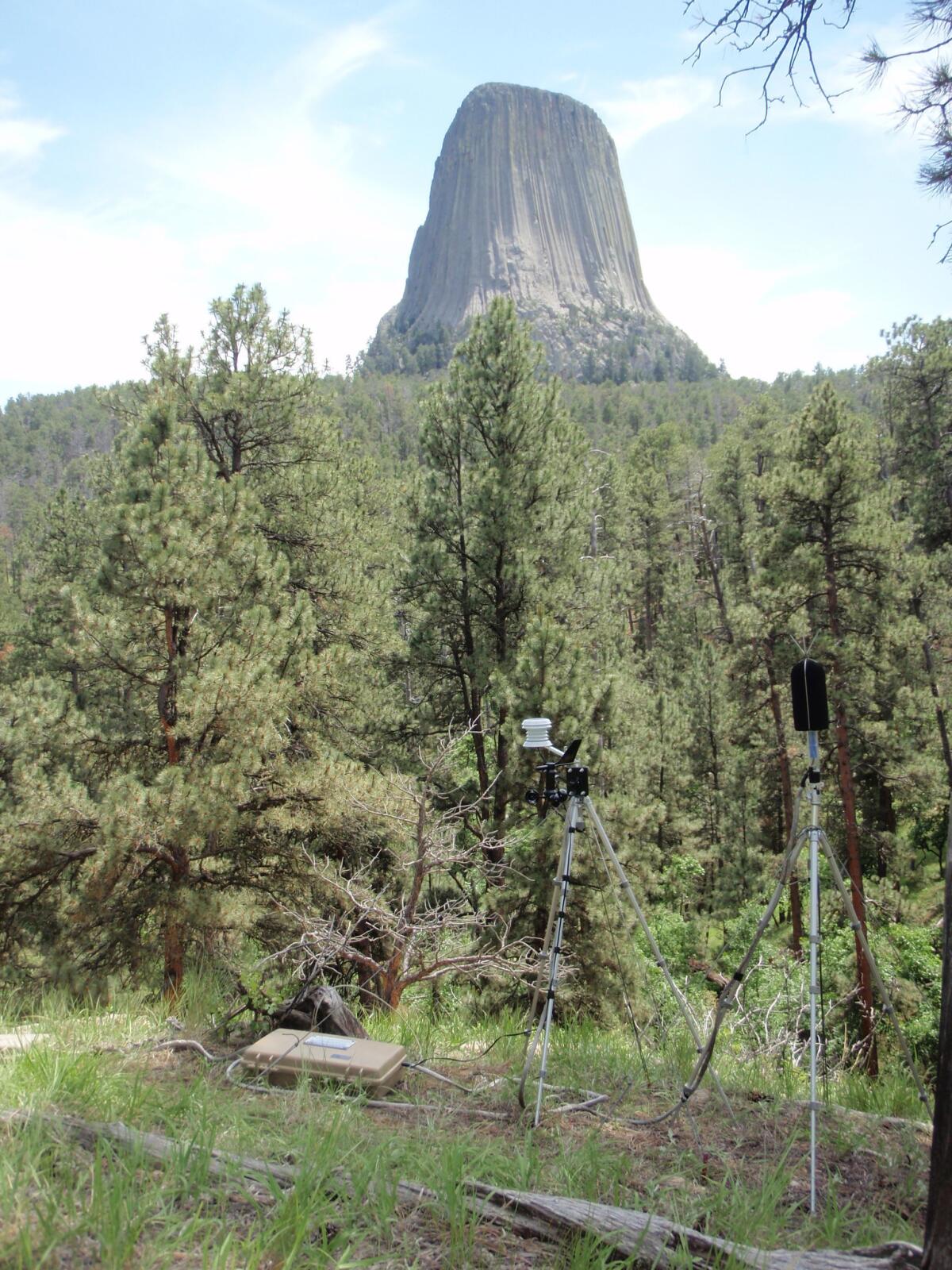Another way humans are polluting the environment: Too much noise
Take a moment to listen here: The iconic sound of wolves howling in Yellowstone National Park; the bizarre shrieks and bellows of a bugling elk in the Rockies; the chirping and trilling of birds as a car zooms by.
Natural sounds are an integral, yet often overlooked, part of the way we experience national parks and other public lands. But human activities — such as roads, development, and mining and logging operations — are drowning out this soundscape in almost two-thirds of protected areas in the U.S., according to a new study published in Science.
Researchers from Colorado State University and the National Park Service listened closely and determined that humans have doubled the level of background noise in 63% of these protected areas, making it loud enough to disturb people and wildlife.
In 21% of protected areas, human activity has cranked up the background noise so much that it’s 10 times louder than what the scientists estimated to be “natural” conditions.
Here’s another way to think about it:
A doubling of background sound — a 3-decibel increase — makes it harder to hear the natural sounds in an area. If in pristine acoustic conditions you could hear a bird singing from 100 feet away, with anthropogenic noise you could hear it from only 50 feet away, said study leader Rachel Buxton, an acoustic ecologist at Colorado State University.
A 10-fold increase in noise reduces your listening area by 90%.
“We have really good research that shows how important natural sounds are for humans,” said Buxton, who fell in love with natural sounds listening to seabirds on the Aleutian Islands. They enhance mood, improve memory retention and “not only that, they’re just really beautiful.”
The din of road and jet traffic above these levels isn’t just an annoyance. Anthropogenic noise stresses wildlife and, in some cases, alters their behavior.
Noisy neighbors
In the Science study, Buxton and her colleagues analyzed the acoustic footprints of 492 national parks, monuments and other public lands around the continental U.S. Some of these parks are known for their silence, such as Olympic National Park in Washington state. Others sit in the heart of urban areas, such as Rock Creek Park and the National Mall in Washington, D.C.
The National Park Service has collected acoustic measurements for decades. The researchers analyzed the millions of hours of recordings and related them to various landscape features that could influence sound, such as nearby roads, running water, land cover and people. Then they created a computer model that could predict noise levels for parks around the country.
The model could even simulate a scenario in which there were no cars, no airplanes and no people.

Once the researchers figured out this “natural” sound level, they were able to tell how much louder places actually were as a result of human activity. They called this measure “noise exceedance.”
Most protected areas either had low levels of noise exceedance or were “inundated” with high exceedance, the authors wrote.
Perhaps unsurprisingly, the highest exceedance values were in areas with the most human neighbors, such as urban national parks and parks managed by local governments.
On the other hand, most wilderness areas maintained close-to-natural sound levels. Despite their remoteness, however, many of these places are affected by jet noise.
Influence on wildlife
Noise pollution can affect wildlife in a number of ways.
Many predators rely on their sense of hearing to hunt their prey, and too much background noise could mask — or even drown out — subtle sounds.
In snow-covered meadows, foxes listen for the faint rustle of voles beneath their feet and pounce when a critter gets close enough. Bats eavesdrop on prey, and some owls can hear individual footfalls or heartbeats of creatures that could become their next meal.

Other animals may be startled by loud sounds they perceive as a threat. That could prompt them to change their behaviors, such as inducing hyper-vigilance or chronic avoidance of certain areas. Some may just find the noise distracting.
“If an animal is busy listening to some strange foreign noise, it may be distracted from feeding itself or avoiding a predator that’s nearby,” Buxton said.
When it’s too noisy for bats to listen for their prey, they use echolocation to hunt instead »
Noise pollution can also have an effect on things that don’t hear like we do. Spiders don’t have ears, but they sense the vibrations caused by sound waves and use vibrations to communicate.
And don’t forget about plants. If a noisy environment scares off all the rodents or insects that disperse seeds, the plants may cease to grow.
“It goes all the way down to plants. If we went down to soil microbes, it would go down to soil microbes as well,” George Wittemyer, a Colorado State conservation biologist and the paper’s senior author. “When you disrupt part of it it cascades through the whole system.”
Shhhh...
The good news is that compared with other ecological issues, noise pollution is a relatively easy problem to tackle, the researchers said.
Solutions range from high-tech “quiet pavement,” which uses an extra-porous asphalt to minimize car noise, to just putting up signs asking park visitors to please be quiet.
“I think there is a lot of potential for optimism,” Wittemyer said. “It’s not a mystery how to deal with this problem.”
In Colorado, Interstate 70 cuts through the Rocky Mountains west of Denver, inundating Glenwood Canyon and others with highway and railway noise. Several Federal Aviation Administration flight paths also pass over the Rockies. If the routes were positioned over the freeway to form a “noise corridor,” that would concentrate the sound in one area and spare the others, Wittemyer said.
Light pollution prevents 1 in 3 Earthlings from seeing the Milky Way at night »
In Mill Valley’s Muir Woods National Monument north of San Francisco, researchers and park staff placed signs declaring the Cathedral Grove a “quiet zone.” Just by doing that, sound levels in the ancient redwood forest decreased.
“We value dark skies or the outstanding sceneries, but pristine soundscapes are sought after by these visitors as well,” said Megan McKenna, an acoustic biologist for the National Park Service’s Natural Sounds and Night Skies Division and a study coauthor.
Audio recordings by: Jacob Job / Colorado State University Sound and Light Ecology Team
MORE IN SCIENCE
Detailed look at the global warming ‘hiatus’ again confirms that humans are changing the climate
Presidential politics has increased job stress and sapped workers' productivity, psychologists say
Here's how hundreds of tons of plastic trash end up in Arctic Ocean




